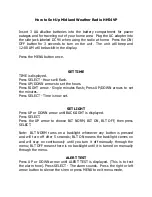
Important:
• Electrostatic discharge (ESD) sensitive device
• ESD can damage the device. Damage from inappropriate handling is not covered by warranty.
• Use proper handling procedures to prevent ESD damage. Proper handling procedures include leaving devices in their
anti-static packaging until ready for use; wearing anti-static wrist straps; and assembling units on a grounded, static-
dissipative surface.
Models
Models
Frequency
Power
I/O
DX80DR9M-H6
900 MHz ISM Band
Battery integrated into the housing
Inputs: 1-Wire serial interface for one 1-wire serial sensing device
DX80DR2M-H6
2.4 GHz ISM Band
DX80DR9M-H6D
900 MHz ISM Band
10 V DC to 30 V DC
DX80DR2M-H6D
2.4 GHz ISM Band
Configuration Instructions
Setting Up Your MultiHop Network
To set up and install your wireless MultiHop network, follow these steps:
1. If your radios have DIP switches, configure the DIP switches of all devices.
2. Connect the sensors to the MultiHop radios if applicable.
3. Apply power to all devices.
4. If your MultiHop radio has rotary dials, set the MultiHop Radio (Slave) ID. If your MultiHop radio has no rotary dials, continue to the next
step.
5. Form the wireless network by binding the slave and repeater radios to the master radio. If the binding instructions are not included in this
datasheet, refer to the quick start guide or product manual.
6. Observe the LED behavior to verify the devices are communicating with each other.
7. Configure any I/O points to use the sensors connected to the Sure Cross devices.
8. Conduct a site survey between the MultiHop radios. If the site survey instructions are not included in this datasheet, refer to the product
manual.
9. Install your wireless sensor network components. If the installation instructions are not included in this datasheet, refer to the product
manual.
For additional information, refer to one of the following documents:
• MultiHop Data Radio Quick Start Guide:
• MultiHop Data Radio Instruction Manual:
• MultiHop Register Guide:
Configure the DIP Switches
Before changing DIP switch positions, disconnect the power. For devices with batteries integrated into the housing, remove the battery(ies) for at
least one minute to reboot the device. You may also triple-click button 2, then double-click button 2 to reset the device without removing the battery.
Any changes made to the DIP switches are not recognized until after power is cycled to the device.
Access the Internal DIP Switches
Follow these steps to access the internal DIP switches.
1. Unscrew the four screws that mount the cover to the bottom housing.
2. Remove the cover from the housing without damaging the ribbon cable or the pins the cable plugs into.
3. Gently unplug the ribbon cable from the board mounted into the bottom housing. For integrated battery models (no ribbon cable), C housing
models (ribbon cable is glued down), and Class I, Division 2 certified devices (ribbon cable is glued down), skip this step.
4. Remove the black cover plate from the bottom of the device's cover.
The DIP switches are located behind the rotary dials.
5. Make the necessary changes to the DIP switches.
6. Place the black cover plate back into position and gently push into place.
7. If necessary, plug the ribbon cable in after verifying that the blocked hole lines up with the missing pin.
8. Mount the cover back onto the housing.
DIP Switch Settings (MultiHop M-H6 Model)
Switches
Device Settings
1
2
3
4
5
6
7
8
Serial line baud rate 19200 OR User defined receiver slots
OFF
OFF
Sure Cross
®
MultiHop H6 Data Radio
2
www.bannerengineering.com - Tel: + 1 888 373 6767
P/N 152725 Rev. J

























